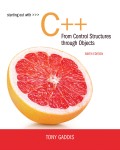
Explanation of Solution
Appending a node:
It is the process of adding a new node at the end of a linked list.
Member function for appending a node:
The following member function is used to append the received value into a list at end:
//Definition of appendNode() function
void IntList::appendNode(int num)
{
//Declare a structure pointer variables
ListNode *newNode, *dataPtr = nullptr;
//Assign a new node
newNode = new ListNode;
//Store the argument value into "newNode"
newNode->value = num;
//Assign the next pointer to be "NULL"
newNode->next = nullptr;
//Condition to check whether the list is empty or not
if (!head)
//If true, make newNode as the first node
head = newNode;
//else part
else
{
//Store head value into dataPtr
dataPtr = head;
//Loop to find the last node in the list
while (dataPtr->next)
//Assign last node to the structure variable
dataPtr = dataPtr->next;
//Insert newNode as the last node
dataPtr->next = newNode;
}
}
Explanation:
Consider the function named “appendNode()” to insert the received value “num” at end of the list.
- Make a new node and assign a received value “num” into the node.
- Using “if…else” condition check whether the list is empty or not.
- If the “head” node is empty, assign a new node into “head” pointer.
- Otherwise, make a loop to find a last node in the list and insert the value at end of the list.
Inserting a node:
It is the process of adding a new node at a specific location in a list.
Member function for inserting a node:
The following member function is used to insert the received value into a list at specific location:
//Definition of insertNode() function
void IntList::insertNode(int num)
{
/*Declare a structure pointer variables*/
ListNode *newNode, *dataPtr, *prev = nullptr;
//Assign a new node
newNode = new ListNode;
//Store the argument value into "newNode"
newNode->value ...
Want to see the full answer?
Check out a sample textbook solution
Chapter 18 Solutions
EBK STARTING OUT WITH C++ FROM CONTROL
- Describe three (3) Multiplexing techniques common for fiber optic linksarrow_forwardCould you help me to know features of the following concepts: - commercial CA - memory integrity - WMI filterarrow_forwardBriefly describe the issues involved in using ATM technology in Local Area Networksarrow_forward
- For this question you will perform two levels of quicksort on an array containing these numbers: 59 41 61 73 43 57 50 13 96 88 42 77 27 95 32 89 In the first blank, enter the array contents after the top level partition. In the second blank, enter the array contents after one more partition of the left-hand subarray resulting from the first partition. In the third blank, enter the array contents after one more partition of the right-hand subarray resulting from the first partition. Print the numbers with a single space between them. Use the algorithm we covered in class, in which the first element of the subarray is the partition value. Question 1 options: Blank # 1 Blank # 2 Blank # 3arrow_forward1. Transform the E-R diagram into a set of relations. Country_of Agent ID Agent H Holds Is_Reponsible_for Consignment Number $ Value May Contain Consignment Transports Container Destination Ф R Goes Off Container Number Size Vessel Voyage Registry Vessel ID Voyage_ID Tonnagearrow_forwardI want to solve 13.2 using matlab please helparrow_forward
- a) Show a possible trace of the OSPF algorithm for computing the routing table in Router 2 forthis network.b) Show the messages used by RIP to compute routing tables.arrow_forwardusing r language to answer question 4 Question 4: Obtain a 95% standard normal bootstrap confidence interval, a 95% basic bootstrap confidence interval, and a percentile confidence interval for the ρb12 in Question 3.arrow_forwardusing r language to answer question 4. Question 4: Obtain a 95% standard normal bootstrap confidence interval, a 95% basic bootstrap confidence interval, and a percentile confidence interval for the ρb12 in Question 3.arrow_forward
- Programming Logic & Design ComprehensiveComputer ScienceISBN:9781337669405Author:FARRELLPublisher:Cengage
 C++ for Engineers and ScientistsComputer ScienceISBN:9781133187844Author:Bronson, Gary J.Publisher:Course Technology Ptr
C++ for Engineers and ScientistsComputer ScienceISBN:9781133187844Author:Bronson, Gary J.Publisher:Course Technology Ptr C++ Programming: From Problem Analysis to Program...Computer ScienceISBN:9781337102087Author:D. S. MalikPublisher:Cengage Learning
C++ Programming: From Problem Analysis to Program...Computer ScienceISBN:9781337102087Author:D. S. MalikPublisher:Cengage Learning  EBK JAVA PROGRAMMINGComputer ScienceISBN:9781305480537Author:FARRELLPublisher:CENGAGE LEARNING - CONSIGNMENT
EBK JAVA PROGRAMMINGComputer ScienceISBN:9781305480537Author:FARRELLPublisher:CENGAGE LEARNING - CONSIGNMENT Programming with Microsoft Visual Basic 2017Computer ScienceISBN:9781337102124Author:Diane ZakPublisher:Cengage Learning
Programming with Microsoft Visual Basic 2017Computer ScienceISBN:9781337102124Author:Diane ZakPublisher:Cengage Learning Microsoft Visual C#Computer ScienceISBN:9781337102100Author:Joyce, Farrell.Publisher:Cengage Learning,
Microsoft Visual C#Computer ScienceISBN:9781337102100Author:Joyce, Farrell.Publisher:Cengage Learning,





